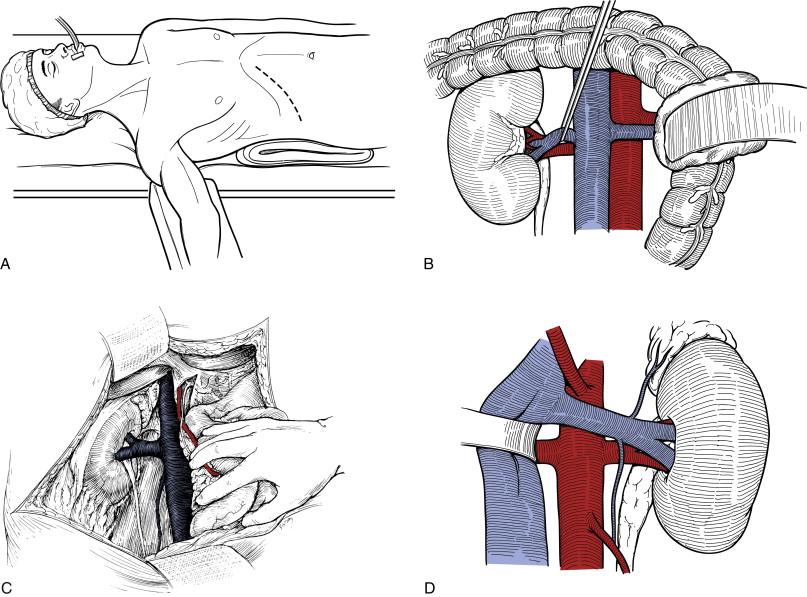Physical Address
304 North Cardinal St.
Dorchester Center, MA 02124
Extraanatomic revascularization of the renal arteries using the splenic or hepatic branches of the celiac trunk for inflow generally yields inferior results when compared with traditional aortorenal bypass. These procedures are usually reserved for patients in whom exposure of the aorta is considered difficult or dangerous. Splenorenal revascularization was initially described by Thompson and Smithwick in 1952 as a splenic artery transposition in a patient with hypertension secondary to unilateral renal disease, and successful bypass with autogenous grafts was reported later in the same decade. The use of the hepatic circulation for revascularization of the right renal artery was not described until 1977, and since then, there have been several larger series detailing both procedures. Extraanatomic renal artery bypasses continue to be used as component hybrid endovascular approaches to abdominal aortic aneurysm repair where revascularization of the renal arteries from the hepatic and splenic circulation allowed extension of an endovascular seal zone to the superior mesenteric artery. In addition, extraanatomic renal artery bypass has been described as a salvage maneuver for inadvertent coverage of the renal arteries during endovascular aneurysm repair.
Imaging. Variable anatomy of the arterial branches of the celiac artery and, in particular, the hepatic arterial circulation is observed in up to 40% of patients, making preoperative imaging essential. The increased fidelity of fine-cut helical computed tomography or magnetic resonance angiography has led to these modalities being used as first-line studies.
Renal insufficiency. The presence of renal insufficiency as determined by a low glomerular filtration rate may preclude the use of gadolinium-based contrast agents, and hydration with sodium bicarbonate may be necessary to decrease the risk of contrast nephropathy.
An anomalous origin of the right hepatic artery off the gastroduodenal artery precludes the sacrifice or use of the gastroduodenal artery during right renal artery revascularization.
The gastroduodenal artery is a critical collateral in patients with occlusive disease or superior mesenteric artery disease and cannot be used for right renal artery revascularization.
Significant occlusive disease at the origin of the celiac artery precludes splenorenal or hepatorenal bypass.
A heavily calcified splenic artery cannot be easily mobilized, and a tortuous splenic artery may be subject to kinking during transposition. A bypass graft with an end-to-side anastomosis off the splenic artery is an alternate approach.
Hepatic insufficiency precludes the use of the hepatic artery for right renal artery revascularization. Despite hepatic blood supply from the portal vein, diversion of even a fraction of hepatic artery flow may prove detrimental.
The common hepatic artery lies anterior to the portal vein and to the left of the bile duct. Both the vein and the duct, as well as the duodenum, are at risk of injury during exposure of the hepatic artery.
The splenic artery travels along the superior border of the pancreas, where it gives off multiple small-branch vessels. The pancreas is at risk of injury during mobilization of the splenic artery.
The spleen is at risk of injury during a splenorenal bypass.
The celiac trunk originates from the anterior surface of the aorta at the T12-L1 interspace and consists of three branches: the left gastric artery, the splenic artery, and the common hepatic artery. The common hepatic artery courses anterior of and to the right along the superior border of the pancreas. It then runs along the right side of the lesser omentum, entering the hepatoduodenal ligament cranial to the pylorus. The common hepatic artery almost always lies anterior to the portal vein and to the left of the bile duct. Because it courses toward the hilum of the liver, it gives off the gastroduodenal artery, which is an important collateral between the celiac and the superior mesenteric artery circulation. The hepatic artery travels toward the liver, superior and cephalad to the common bile duct, and terminates at the liver hilum as the right and left hepatic arteries. The splenic artery travels along the superior border of the pancreas, where it gives off the dorsal pancreatic artery and several small branches and terminates at the spleen ( Fig. 37-1 ).

For hepatorenal bypasses, a reversed saphenous vein is preferred. Because this bypass lies close to the duodenum, an autogenous conduit should be more resistant to infection. However, when the saphenous vein is less than 4 mm in caliber or absent, a 6-mm polytetrafluoroethylene or polyester graft can be used. For splenorenal bypasses, transposition of the splenic artery is preferred; alternatively, a saphenous vein graft or, if necessary, a synthetic graft can be used.
Become a Clinical Tree membership for Full access and enjoy Unlimited articles
If you are a member. Log in here